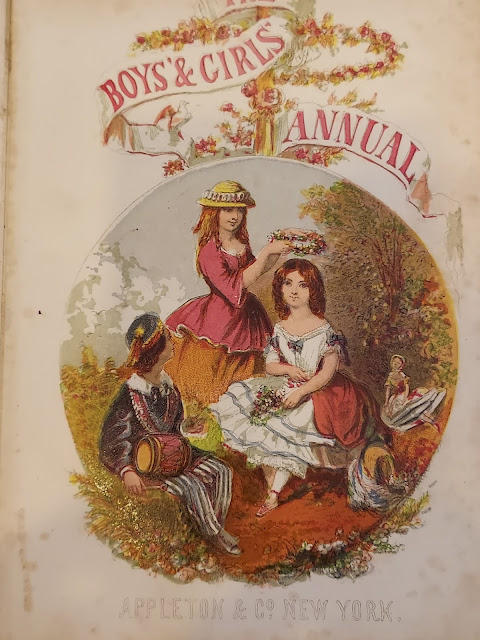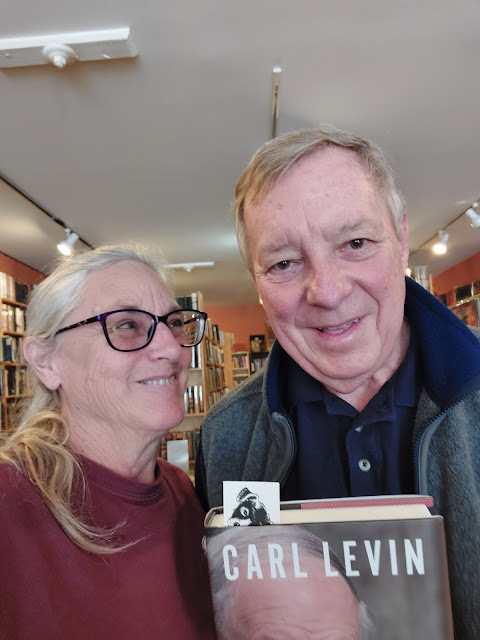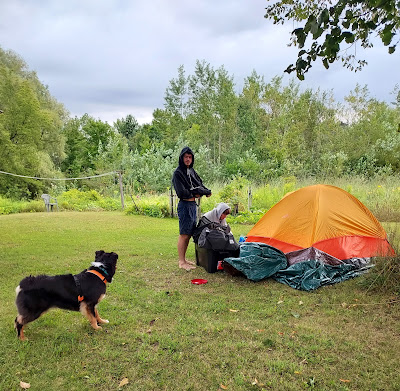 |
| Winter will come! |
First, Books (Because, After All....)
For one thing, I purchased a very large collection of books and have been busy boxing and unboxing, boxing and unboxing, repricing, shelving when and where possible, exclaiming over treasures, and generally doing what dealers in old books do from time to time. Today’s illustrations for the first section of my post, in fact, are from a somewhat shabby but intriguing volume called The American Boys’ and Girls’ Annual: A Christmas and New Year’s Present for Young People. This particular annual (assuming that one came out every year) was published in 1861 and so appeared for the first Christmas of the Civil War. I imagine it as a book Louisa May Alcott would have known, don’t you? Little did our country realize on that Christmas of 1861 that the war would last through three more brutal winters and only come to a close in the spring of 1865.
 |
| Imagine the March girls, all dressed up. |
Partly as a result of the recent private library purchase, though also (at least initially) as an escape from present concerns and worries, I read a lot of books from past American centuries during August. The first several on my “Books Read” list do not reflect that direction, but remember, I always have several books going at once. Anyway – or ennaway, as the Norwegian farmers say -- here they are:
Books Read August 2024
117. Justice, Damaged. The Devil You Know (fiction). This book is the first in a fan fiction trilogy. If you are not familiar with fan fiction (I was not), here is my take on it: The writer begins with characters and a universe already established by another writer or writers, either in book form or (often) in a television series. The Devil You Know brings together characters from two different series, “Dexter” and “Buffy the Vampire Slayer.” Dexter Morgan, a serial killer of serial killers, enters the world of vampires, other demons, and their Slayers, thanks to his talented stepdaughter. Dexter’s sister, Deb, a foul-mouthed cop, gets in on the action, too – and there is plenty of action, but also a lot of emotion, along with the questioning of emotions and perceptions, all vividly written to keep the reader turning pages until late in the night. As far as Damaged Justice (a pen name) knows, I am the first reader of The Devil You Know who came to it with no background in either Dexter or Buffy, and it still worked for me, as I was able to pick up the characters’ backgrounds as their story moved along. If you would like to read this book online, here is the link.
118. Taleb, Nassim Nicholas. The Black Swan: The Impact of the Highly Improbable (nonfiction). When something unpredictable occurs, some event that carries a huge impact, we make up narratives after the fact to explain it, as if we should have seen it coming. This denial of the randomness of the universe is itself universal, Taleb writes, but we can learn to inoculate ourselves against the effects of black swans while positioning ourselves to benefit from them when they appear. Fascinating ideas from a highly original thinker.
119. Trevor, Douglas. Girls I Know (fiction). Walt has dropped out of his graduate program at Harvard and now works half-heartedly but contentedly at a couple of low-level jobs that allow him to stay in Boston, his only life ambition to stay in Boston and have breakfast every day at the Early Bird Café, where everyone knows him. Maybe he will ask the waitress out on a date. Calm, ordinary life is shattered when a shooter enters the café and kills the owners and waitress. The shooter’s gun jams, however, when he tries to pull the trigger on Walt, who must then stagger on with the rest of his life. Becoming friends with a rich, hyperactive undergraduate girl obsessed with a nonfiction book project challenges both Walt and Ginger in their assumptions about life. And then there is Mercedes, the child of the dead restaurant owners, who hasn’t spoken a word since her mother and father were killed. Can Walt really help her? The city of Boston is a major character in this book of ordinary people making their way through trauma and confusion.
120. Rives, Hallie Erminie (Mrs. Post Wheeler). The Magic Man (fiction). I did not intend to read this novel. It had the look and the opening chapters of hundreds of other 1920s novels, all set on the East Coast and featuring beautiful rich girls. Surprise! Something much more interesting entered the story, as the rich girl’s scientist father sets up an experiment with an amnesiac would-be burgler to prove to one of his European colleagues that environment makes all the difference in the production of criminals vs. successful, honest adults!
121. Olson, Jim. People of the Dune (fiction). One review of Jim Olson’s book, his first novel, called it a parable, and that seems fair. It’s also very clear from the beginning where Olson’s sympathies lie: European immigrants are the “Invading People,” and the mining company moves its equipment in “like vultures circling their prey.” For me, though, the book came alive with the judge’s change of heart, over 100 pages into the book.
"With the pressing collapse of earth’s viability (e.g., the water cycle, biological diversity, climate, and so much more), it may be that the punishing expectations and entitlement of the law of private property can no longer be tolerated. The earth’s viability for supporting life is in the crosshairs. How did the right of private property get to the point where it leads to the death of nature’s web on which all life, even the right to property and profits, depends?"
Good questions. Important questions. Where will we go from here? I remember a couple of precedents for this story from the late 20th century, a “Save the Dunes” that fought Bethelemen Steel in Indiana in the Sixties and another in the late 1970s focused on shoreline in southwest Michigan. See https://www.burnsharbor-in.gov/203/Local-History and https://www.casemine.com/judgement/us/591489d1add7b049345087cd
122. Skinner, Cornelia Otis & Emily Kimbrough. Our Hearts Were Young and Gay (nonfiction). After the well-deserved success of this notable bestseller, Emily Kimbrough went on to write other humorous travel books, all of which I devoured with glee in my younger years. Now I am rediscovering the innocent times of those two young women, traveling “independently” (with letters of credit from their parents, although they had worked and saved to pay their ocean passage themselves). Cornelia and Emily were traveling in the 1920s – 100 years ago! – so naturally the work is dated, and yet, how much does human nature change from one generation to another? And when did I last laugh so hard, unable to stop even when my confused dog jumped up to cover my face with kisses? Good medicine to counteract a surfeit of news and work!
123.
124. Aldrich, Bess Streeter. A Lantern in Her Hand (fiction). Probably the best-known of this Nebraska author’s works, Lantern tells the life of Abbie from girlhood dreams through motherhood on the prairie to her peaceful death, alone with her memories. This novel is historical in that it depicts in detail a period long ago. The characters, however, are ordinary people, not generals or presidents or princesses, and probably we enter more wholeheartedly into their lives because of that. An American story of honest, hard-working, 19th-century Midwesterners. I loved it.
125. Brooks, Geraldine. Dames and Daughters of Colonial Days (nonfiction). Short biographies of girls and women beginning with Anne Hutchinson, this was a book I ordered by mistake. A happy mistake, as it turned out. Very enjoyable reading.
126. Dwight, Margaret Van Horn. A Journey to Ohio in 1810 (nonfiction). Better to read about than to endure this journey of wagons mired in mud, wagoneers rude and blasphemous, horses beaten, the young woman keeping the journal forced to walk miles on end and often sleep on floors in roadside inns. Very interesting window, however, into weeks and weeks of uncomfortable and sometimes dangerous travel from the Eastern seaboard through the wilds of Pennsylvania to Ohio, seen by a young woman who recounts her adventures mile by mile in a journal destined to be sent, when the destination is finally reached, to her best friend back home.
127. Sitwell, Osbert. The Scarlet Tree (nonfiction). Have I been the only person in the U.S. falling asleep over Osbert Sitwell’s memoirs after a luscious, sybaritic session of bedtime reading? His long, lovely sentences, his sensuous descriptions of flowers and music I found completely delightful and soothing. The schoolboy bullying he endured was not a comfort. How could his family pretend not to notice those black eyes? In the end, however, even the mean boys turned out okay, it seems. Or so he says.
128. Gallagher, Nora. Changing Light (fiction). Sent to me by a dear friend, this novel is set in New Mexico during the very secret development of the atomic bomb. A woman from New York has bought land and built a small house where she can paint, far from her artist husband’s jealous criticism. A Czech physicist, working on the “gadget,” has come to see the danger to the world presented by the bomb and wants to prevent its use. And a Catholic priest finds himself in the middle and unsure what he should do. The plot was complicated by possible spies, but for me the ambience of the setting was the novel’s strongest feature.
129. Marron, Dylan. Conversations with People Who Hate Me: 12 Things I Learned from Talking to Internet Strangers (nonfiction). Okay, so he was a "digital content creator," and he lived online. As an openly gay liberal male with strong opinions, Marron quickly found himself the target of hateful comments. After trying a variety of ways to deal with the hurt, he came up with the idea of looking up the haters for conversation -- and that's where things get not only interesting but heart-opening and mind-opening. You need to read it for yourself.
Weather Notes
Our weather has been dry for way too long. We’ll get a stretch of hot (for northern Michigan), muggy weather and clouds, even forecasts for rain, but where are those promised showers? We were supposed to have thunderstorms off and on all day Friday, but only the barest of sprinkles did we see and feel. My farmer friends are hoping not only for rain soon but also for a cold winter with lots of snow, unlike our last winter that almost wasn't.
Garden Notes
At home, my tomatoes are showing a little color at last, jalapeno peppers are shaping up nicely, daisies and phlox are almost ready to give way to anemones and chrysanthemums – and I want to shout, “No, no! It’s too early for 'mums!” Happy about those nightshades, though, by which I mean the peppers and tomatoes.
Though mention of nightshades reminds me to mention and show wild fungi that have appeared in my yard and near neighborhood recently. I let the puffball grow a few days before harvesting it for my kitchen.
Boletes, on the other hand, I am collecting only with my phone camera. They are too numerous and, for me, too confusing to try to identify as edible or poisonous. And yet they are fascinating! I don’t remember seeing them before. Ever since our last mild winter, 2024 has been an unusual year….
Dog Notes
While I look forward to another visit soon from our Arizona hiking buddies, Little Miss Oblivious, a.k.a. Sunny Juliet, makes do with her dog momma’s company. She is starting to catch onto Frisbee, with the indestructible version known as “Hyper-Pet.” Of course we still have tennis ball play and agility practice, and she still has (kept outdoors) her treasured old raggedy boot, found in the orchard when she was only a puppy.
Bookstore Notes
Today, though, I can’t close with dog notes, because last Thursday Dog Ears Books had a very special visitor, the senior U.S. senator from Illinois, Dick Durbin. It was Senator Durbin’s second visit to my bookstore, and this time, while I forgot to ask him to write in the guestbook, I did remember to get photos. Thank you, Senator Durbin, not only for your visit and your book purchase, but for all you have done in service to our country!














































